 A few weeks ago we published some Air Travel Tips for those who suffer from low back pain, focusing primarily on dealing with carry-on luggage. But we all know the flight itself can also aggravate low back pain. Here are some ways to stay as comfortable as possible during your flight.
A few weeks ago we published some Air Travel Tips for those who suffer from low back pain, focusing primarily on dealing with carry-on luggage. But we all know the flight itself can also aggravate low back pain. Here are some ways to stay as comfortable as possible during your flight.
Be proactive with the airlines!
- Be sure to get an aisle seat. If you consistently suffer from low back pain, you can request an aisle seat out of “medical necessity.” By stating it this way, the airlines will go out of their way to find you an aisle seat. It is easier to exit the seat in case you have to use a restroom, or if an emergency occurs. An aisle seat also allows you the opportunity to stand up and walk around for exercise, which can reduce the irritation of low back pain and reduce the chance of blood clots. I can provide my patients with a letter to travel which reports your condition thus helping you achieve special consideration.
- Request a wheelchair. Make sure the airline knows you would like a wheelchair. They will handle your carry-on, get you through security quicker, and get you to and from the gate in a safe, timely manner. Ideally, you should make this request at the time of your reservation, but you can also tell a flight attendant prior to landing and they will have it arranged by the time you de-plane at your final destination. Since there is no way to know how long the security line will be or how long the distance will be between gates or to baggage claim, having a wheelchair pre-arranged is wise.
- Request a row of seats. Typically, if the plane isn’t full, you can ask for a row of seats that are empty so you can put the arm rests up and spread out or lay down, which may be more comfortable.
- Recline your seat. Depending on your type of low back condition, you may feel more comfortable either in a vertical upright position or reclined. Some seats, such as those in an exit row or the last row, do not recline so be sure to ask to make sure your seat is adjustable. when booking your flight or when you check-in. There are websites, such as seatexpert.com, that specialize in providing information about different airlines and types of planes, and the most comfortable places to sit.
- Stay stretched. Prolonged sitting has many negative effects on muscles, joints, and circulation. Performing stretches from sitting and standing positions can help, especially on long flights. Ask me to show you some easy-to-perform exercises that can be done in confined spaces.
- Pre-board. This option allows you to board the plane first and gives you extra time.
- Use a handicap parking permit. Consider this if walking is challenging to you. We can assist you in obtaining this designation, and it will help you to park close to the entrance at the airport.
- Get a seat assignment. Getting “bumped” is a much more common practice these days due to airlines over-booking flights. If you do not initially obtain a seat assignment, call your airline immediately to obtain your seat. Getting bumped can mean a delay of a couple of hours or even a couple of days.
Sit With Support
Using a special back support (if possible) or even a rolled up towel, pillow, or airline blanket between your back and seat can really help decrease low back pain. A small water bottle (tighten the cap!) is also a good option, and can be obtained at one of the shops after passing through security.
The bottom line is your comfort. If a position feels good and relieving, it will be of benefit to you. Be sure to sit supported with your knees at a right (90 degree) angle, pushing your feet into the floor. This is especially helpful during take-offs and landings. Periodically stretch your legs out under the seat ahead of yours. You may have to place your briefcase or carry-on behind your legs, in front of your seat to open up the space so that you can stretch out. This of course, only applies after take off, and before landing preparation.
Lastly, drink plenty of water, slip your shoes off at times, get up and walk periodically, carry a note from us for special needs, and most importantly, when you return back home, get checked by a chiropractor! The routine use of chiropractic care can allow you in most cases to correct or avoid the most common causes of lower back pain known as vertebral subluxation. Maintaining spine health can lead to many miles of uninterrupted healthful travel, so that you can truly enjoy your flight!
Photo credit: ![]() JoshuaDavisPhotography via Compfight
JoshuaDavisPhotography via Compfight

